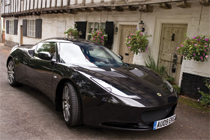They have done it again, but better. Lotus has evolved a real sports car with all the agility, phenomenal handling and speed they are so justly famous for but now packaged in a completely new four-seat supercar body. This Lotus, with its smooth 3.5-liter V6 engine, which Lotus has customized in its own workshops and joined to a six-speed manual gearbox, is the most rigorously tested Lotus model ever. From Arctic to desert via Hethel village high street in the English county of Norfolk, it has been hammered hard and passed the test. To prove the maker’s faith in the new car, it even has a three-year/90,000-kilometer warranty.
Described as a four-seat sports car, Lotus says it is the only current production mid-engine 2+2 sports car in the world. The Evora, created from scratch and sharing fewer than five percent of components (mostly nuts and bolts) with the Exige and Elise in just 27 months, does have four seats if you want them, but the rear seats, as one would expect in a sports car, are slightly cramped. The car is also available as a two-seater; the rear area becoming a luggage platform. Trunk space, says Lotus, accommodates “two sets of golf clubs”.
This, says Lotus, is just the start. More powerful versions, an auto and possibly a cabrio, are on the way.
Tony Shute, the Evora program manager, said that the development of the Evora was supported by lots of Lotus’ sophisticated computer simulation packages. Design and engineering teams focused totally on getting it right, something a “can do” company like Lotus is able to achieve.
The Evora shouts its Lotus heritage — sleek, low and a delicious flowing profile with flat underbody and rear diffuser that acts as slippery as it looks in the damp Norfolk air it was born in. A huge low-slung air scoop at the front end and a tactile set of haunches over the rear wheels, the Evora is every millimeter a race-bred sports car.
The car sits somewhere between a Porsche and the company’s minimalist two-seaters with just the right balance of luxury and perfect practicality, although the switches and buttons are oddly sited and the sat-nav from Alpine is slightly annoying. Reflections occasionally catch the instruments in the left side of the binnacle and the windscreen reflects the top of the dash rather too perfectly. That said these passing observations certainly do not detract from the core excellence of the Evora — its sheer drivability.
The low positioning of the supportive seats, which are resistant rather than soft, totally involves the driver with the business of driving. Getting into the Evora requires the same gentle gymnastics of getting into their Exige or Elise, but you never did “enter” a Lotus, you put it on like a glove.
Once in, the driver and car become one. Driving, braking and cornering all involve classic “seat-of-the-pants” driving. The car feeds back the information precisely and clearly, and never misbehaves. During a hard session round the company’s private test track and afterward, with the giveaway pungency of heated rubber raising the eyebrow of the slightly suspicious Lotus minder, there had not been a moment that the Evora had done anything even approaching unpredictable.
The ride is sensational with fewer bumps that could be reasonably expected from a stiffened suspension. Traction is impressive even without limited slip differential but with traction control (standard in Europe). As the giveaway rubber smell attested, the generous steering lock that makes town driving painless contributes to the ease of drifting the car given sufficient momentum.
The extraordinarily smooth, super-damped ride and super-sharp handling capabilities make the Evora a one-off experience. It feels precise, assured and has bags of grip provided by Pirelli P-Zero tires even on damply glistening Norfolk roads. The power-assisted rack and pinion steering is precisely weighted, and as power-assisted steering systems go this has to be one of the very best. It will come as no surprise to Lotus aficionados to learn that it is an old fashioned hydraulic set-up. The monstrous Bosch brakes are very reassuring, and low-intrusion electronic chassis aids are there to combine safety with the sheer joy of driving.
The Evora is powered by, very surprisingly but do read on, a Toyota V6 unit. As one would expect, it has undergone some sophisticated reworking and engine electronics that boost the power but lose none of the reliability. Sitting transversely just to the rear of the 55-litre fuel tank, its output — 276bhp and 252lb ft of torque — is mated to a six speed manual box, the first in Lotus history. The result is a smooth engine with a good supply of power in mid-range although lacking the urge of a turbo or supercharged engine, altogether very useful for road use and less frequent gear changes. However, it is really happy above 5,000 rpm where it sings blithely and churns out all you could want and, when added to the quality handling, the Evora will leave many a supercar in its wake. It also means the Evora can throw its modest 1,382 kg mass from zero to 100 kph in 5 seconds past 160 kph in 12.3 seconds, with its very aerodynamic shape allowing for a top speed of 260 kph.
Push the revs to 6,600 (7,000 with the optional dash-mounted sport button that very much sharpens throttle response) and the exhaust delivers a keening sharp-edged wail that turns heads in quiet country lanes — or anywhere else.
Counter-intuitively, fun can be green; fuel economy has long been a Lotus strength and the Evora’s Combined figure is 32.5mpg. CO2 emissions are 205g/km, a figure that is likely to reduce during further development.
The great thing about the Evora is that it combines reasonable practicality with technical sophistication in a great-looking sports car.


